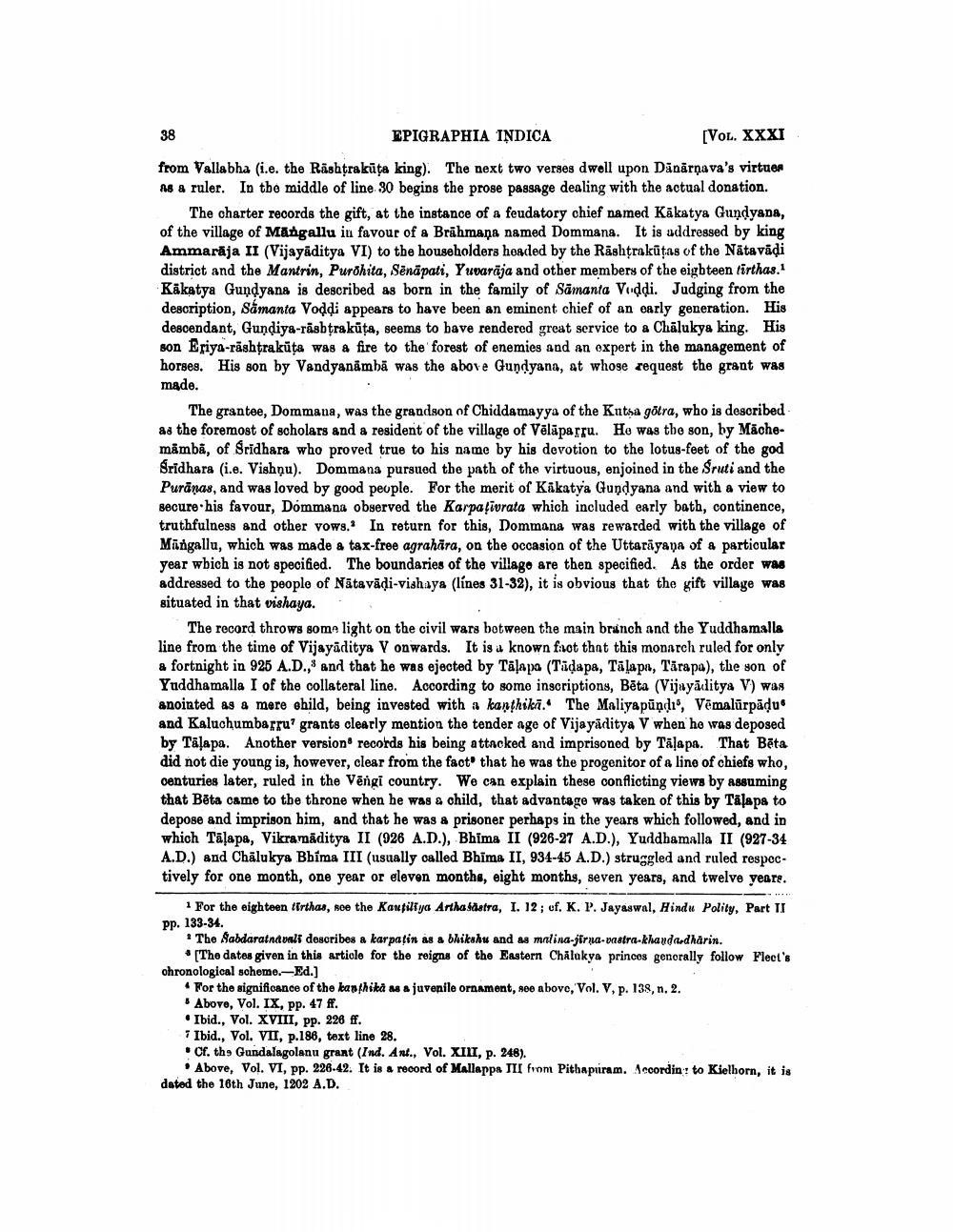________________
38
EPIGRAPHIA INDICA
(VOL. XXXI
from Vallabha (i.e. the Rashtrakūta king). The next two verses dwell upon Dānārņava's virtuer As a ruler. In the middle of line 30 begins the prose passage dealing with the actual donation.
The charter records the gift, at the instance of a feudatory chief named Kākatya Gundyana, of the village of Mangallu in favour of a Brāhmaṇa named Dommana. It is addressed by king Ammarāja II (Vijayaditya VI) to the householders headed by the Rashtrakūtas of the Nātavādi district and the Mantrin, Purohita, Sēnāpati, Yuvarāja and other members of the eighteen tirthas.! Käkatya Gundyana is described as born in the family of Sämanta Veddi. Judging from the description, Samanta Voddi appears to have been an eminent chief of an early generation. His descendant, Gundiya-rāsbţrakūta, seems to bave rendered great service to a Chālukya king. His son Eriya-rashtrakūta was a fire to the forest of enemies and an expert in the management of horses. His son by Vandyanām bā was the above Gundyana, at whose request the grant was made.
The grantee, Dommana, was the grandson of Chiddamayya of the Kutsa götra, who is described as the foremost of scholars and a resident of the village of Vēlāparru. He was the son, by Māchemâmbă, of Sridhara who proved true to his name by his devotion to the lotus-feet of the god Sridhara (i.e. Vishņu). Dommana pursued the path of the virtuous, enjoined in the Sruti and the Purānas, and was loved by good people. For the merit of Kikatya Gundyana and with a view to secure his favour, Dommana observed the Karpațivrata which included early bath, continence, truthfulness and other vows. In return for this, Dommana was rewarded with the village of Mingallu, which was made a tax-free agrahāra, on the occasion of the Uttarāyaṇa of a particular year wbich is not specified. The boundaries of the village are then specified. As the order was addressed to the people of Nātavādi-vishaya (línes 31-32), it is obvious that the gift village was situated in that vishaya. .
The record throws some light on the civil wars between the main branch and the Yuddhamalla line from the time of Vijayāditya V onwards. It is a known filot that this monarch ruled for only a fortnight in 925 A.D.,' and that he was ejected by Tālapa (Tidapa, Tālapa, Tārapa), the son of Yuddhamalla I of the collateral line. According to some inscriptions, Bēta (Vijayāilitya V) was anointed as a mere child, being invested with a kanthikā.. The Maliyapūndi', Vemalūrpadu and Kaluchumbarru' grants clearly mention the tender age of Vijayāditya V when he was deposed by Tālapa. Another version records his being attacked and imprisoned by Talapa. That Bēta did not die young is, however, clear from the fact that he was the progenitor of a line of chiefs who, centuries later, ruled in the Vēngi country. We can explain these conflicting views by Assuming that Bēta came to the throne when he was a child, that advantage was taken of this by Tāļapa to depose and imprison him, and that he was a prisoner perhaps in the years which followed, and in which Tālapa, Vikramaditya II (926 A.D.), Bhima II (926-27 A.D.), Yuddhamalla II (927-34 A.D.) and Chalukya Bhima III (usually called Bhima II, 934-45 A.D.) struggled and ruled respectively for one month, one year or eleven months, eight months, seven years, and twelve years.
1 For the eighteen tirthas, noe the Kantiliya Anthasdetra, I. 12 ; of. K. P. Jayaswal, Hindu Polity, Part II Pp. 133-34.
* The Sabdaratnawali describes a karpatin as a bhikshu and as malina-jirna-vastra-khaudardharin.
*[The dates given in this article for the reigns of the Eastern Chalakya princos generally follow Flect's ohronological scheme.-Ed.]
For the significance of the kanthikä as a juvenile ornament, noe above, Vol. V, p. 138, n. 2. Above, Vol. IX, pp. 47 ff. • Ibid., Vol. XVIII, pp. 226 ff.
Ibid., Vol. VII, p.186, text line 28. . Cf. th, Gundalagolanu grant (Ind. Ant., Vol. XIII, p. 248).
Above, Vol. VI, pp. 226-42. It is a record of Mallappa JII from Pithapriram. Accordin: to Kielhorn, it is dated the 16th June, 1202 A.D.




